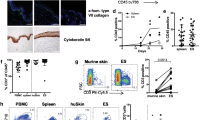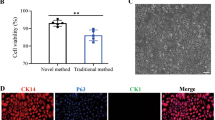Abstract
Dermatitis is a group of highly pruritic chronic inflammatory skin diseases which represents a major public-health problem worldwide. The prevalence of dermatitis has increased in recent years affecting up to 20% of the general population. Acute skin lesions are characterized by extensive degrees of intercellular edema of the epidermis (spongiosis) and a marked perivenular inflammatory cell infiltrate in the dermis. Keratinocytes within eczematous lesions exhibit a modified expression of proinflammatory cytokines, chemokines and cell-surface molecules. The pathophysiological puzzle of dermatitis is far from being elucidated completely, but skin infiltration of activated memory/effector T cells are thought to play the pivotal role in the pathogeneses. The aim of this study was the set-up of organotypic models mimicking the symptoms of eczematous dermatitis to provide a tool for therapeutic research in vitro. Therefore activated T cells (ATs) were integrated in organotypic skin and epidermis equivalents (SE, EE). These models enabled the reproduction of several clinical hallmarks of eczematous dermatitis: (1) T cells induce keratinocyte apoptosis, which leads to a reduced expression of the adhesion molecule E-cadherin (E-cad) and disruption of the epidermal barrier. (2) Expression of intercellular adhesion molecule-1 (ICAM-1) allows the attachment of leukocytes to epidermal cells. (3) Upregulation of neurotrophin-4 (NT-4) in the epidermis is thought to mediate pruritus in lesions by supporting nerve outgrowth. (4) Elevated levels of pro-inflammatory cytokines (IL-1α and IL-6) and chemokines (IL-8, IP-10, TARC, MCP-1, RANTES and eotaxin) amplify the inflammatory response and lead to an influx of secondary immunocells into the skin. The therapeutics dexamethasone and FK506 markedly reduce cytokines/chemokines production and epidermal damaging in these models. These data underline that activated memory/effector T cells induce eczematous changes in this HaCaT cell based organotypic skin equivalent. Furthermore it can be concluded that these models make it possible to investigate targets of therapeutics in skin.



Similar content being viewed by others
References
Anttila HS, Reitamo S, Erkko P, Ceska M, Moser B, Baggiolini M (1992) Interleukin-8 immunoreactivity in the skin of healthy subjects and patients with palmoplantar pustulosis and psoriasis. J Invest Dermatol 98:96–101
Barker JN, Mitra RS, Griffiths CE, Dixit VM, Nickoloff BJ (1991) Keratinocytes as initiators of inflammation. Lancet 337:211–214
Baus E, Andris F, Dubois PM, Urbain J, Leo O (1996) Dexamethasone inhibits the early steps of antigen receptor signaling in activated T lymphocytes. J Immunol 156:4555–4561
Bekersky I, Fitzsimmons W, Tanase A, Maher RM, Hodosh E, Lawrence I (2001) Nonclinical and early clinical development of tacrolimus ointment for the treatment of atopic dermatitis. J Am Acad Dermatol 44:S17–S27
Boukamp P, Petrussevska RT, Breitkreutz D, Hornung J, Markham A, Fusenig NE (1988) Normal keratinization in a spontaneously immortalized aneuploid human keratinocyte cell line. J Cell Biol 106:761–771
Bunikowski R, Mielke M, Skarabis H, Herz U, Bergmann RL, Wahn U, Renz H (1999) Prevalence and role of serum IgE antibodies to the Staphylococcus aureus-derived superantigens SEA and SEB in children with atopic dermatitis. J Allergy Clin Immunol 103:119–124
Dustin ML, Singer KH, Tuck DT, Springer TA (1988) Adhesion of T lymphoblasts to epidermal keratinocytes is regulated by interferon gamma and is mediated by intercellular adhesion molecule 1 (ICAM-1). J Exp Med 167:1323–1340
Gavrieli Y, Sherman Y, Ben Sasson SA (1992) Identification of programmed cell death in situ via specific labeling of nuclear DNA fragmentation. J Cell Biol 119:493–501
Grabbe S, Schwarz T (1998) Immunoregulatory mechanisms involved in elicitation of allergic contact hypersensitivity. Immunol Today 19:37–44
Grewe M, Bruijnzeel-Koomen CA, Schopf E, Thepen T, Langeveld-Wildschut AG, Ruzicka T, Krutmann J (1998) A role for Th1 and Th2 cells in the immunopathogenesis of atopic dermatitis. Immunol Today 19:359–361
Grewe M, Gyufko K, Schopf E, Krutmann J (1994) Lesional expression of interferon-gamma in atopic eczema. Lancet 343:25–26
Grewe M, Vogelsang K, Ruzicka T, Stege H, Krutmann J (2000) Neurotrophin-4 production by human epidermal keratinocytes: increased expression in atopic dermatitis. J Invest Dermatol 114:1108–1112
Griffiths CE, Voorhees JJ, Nickoloff BJ (1989) Characterization of intercellular adhesion molecule-1 and HLA-DR expression in normal and inflamed skin: modulation by recombinant gamma interferon and tumor necrosis factor. J Am Acad Dermatol 20:617–629
Hanifin JM, Tofte SJ (1999) Update on therapy of atopic dermatitis. J Allergy Clin Immunol 104:S123-S125
Herz U, Bunikowski R, Renz H (1998) Role of T cells in atopic dermatitis. New aspects on the dynamics of cytokine production and the contribution of bacterial superantigens. Int Arch Allergy Immunol 115:179–190
Ibanez CF, Ernfors P, Timmusk T, Ip NY, Arenas E, Yancopoulos GD, Persson H (1993) Neurotrophin-4 is a target-derived neurotrophic factor for neurons of the trigeminal ganglion. Development 117:1345–1353
Kay JE, Benzie CR, Goodier MR, Wick CJ, Doe SE (1989) Inhibition of T-lymphocyte activation by the immunosuppressive drug FK-506. Immunology 67:473–477
Kim DS, Kim HJ, Choi KH, Chung JH, Kim KH, Par KC (2001) UVB-induced GM-CSF production is suppressed by dexamethasone in HaCaT cells. Photodermatol Photoimmunol Photomed 17:121–125
Klunker S, Trautmann A, Akdis M, Verhagen J, Schmid-Grendelmeier P, Blaser K, Akdis CA (2003) A second step of chemotaxis after transendothelial migration: keratinocytes undergoing apoptosis release IFN-gamma-inducible protein 10, monokine induced by IFN-gamma, and IFN-gamma-inducible alpha-chemoattractant for T cell chemotaxis toward epidermis in atopic dermatitis. J Immunol 171:1078–1084
Krueger JG, Krane JF, Carter DM, Gottlieb AB (1990) Role of growth factors, cytokines, and their receptors in the pathogenesis of psoriasis. J Invest Dermatol 94:135S–140S
Lange K, Kleuser B, Gysler A, Bader M, Maia C, Scheidereit C, Korting HC, Schafer-Korting M (2000) Cutaneous inflammation and proliferation in vitro: differential effects and mode of action of topical glucocorticoids. Skin Pharmacol Appl Skin Physiol 13:93–103
Larsen CG, Anderson AO, Appella E, Oppenheim JJ, Matsushima K (1989) The neutrophil-activating protein (NAP-1) is also chemotactic for T lymphocytes. Science 243:1464–1466
Laughter D, Istvan JA, Tofte SJ, Hanifin JM (2000) The prevalence of atopic dermatitis in Oregon schoolchildren. J Am Acad Dermatol 43:649–655
Leung DY (2000) Atopic dermatitis: new insights and opportunities for therapeutic intervention. J Allergy Clin Immunol 105:860–876
Lever R, MacDonald C, Waugh P, Aitchison T (1998) Randomised controlled trial of advice on an egg exclusion diet in young children with atopic eczema and sensitivity to eggs. Pediatr Allergy Immunol 9:13–19
Levin C, Maibach HI (2000) An overview of the efficacy of topical corticosteroids in experimental human nickel contact dermatitis. Contact Dermatitis 43:317–321
Lilly CM, Nakamura H, Kesselman H, Nagler-Anderson C, Asano K, Garcia-Zepeda EA, Rothenberg ME, Drazen JM, Luster AD (1997) Expression of eotaxin by human lung epithelial cells: induction by cytokines and inhibition by glucocorticoids. J Clin Invest 99:1767–1773
Meyle J, Gultig K, Rascher G, Wolburg H (1999) Transepithelial electrical resistance and tight junctions of human gingival keratinocytes. J Periodontal Res 34:214–222
Michel G, Auer H, Kemeny L, Bocking A, Ruzicka T (1996) Antioncogene P53 and mitogenic cytokine interleukin-8 aberrantly expressed in psoriatic skin are inversely regulated by the antipsoriatic drug tacrolimus (FK506). Biochem Pharmacol 51:1315–1320
Mochizuki M, Bartels J, Mallet AI, Christophers E, Schröder JM (1998) IL-4 induces eotaxin: a possible mechanism of selective eosinophil recruitment in helminth infection and atopy. J Immunol 160:60–68
Mukaida N, Gussella GL, Kasahara T, Ko Y, Zachariae CO, Kawai T, Matsushima K (1992) Molecular analysis of the inhibition of interleukin-8 production by dexamethasone in a human fibrosarcoma cell line. Immunology 75:674–679
Nakagawa H, Etoh T, Ishibashi Y, Higaki Y, Kawashima M, Torii H, Harada S (1994) Tacrolimus ointment for atopic dermatitis. Lancet 344:883
Nickoloff BJ, Griffiths CE, Barker JN (1990) The role of adhesion molecules, chemotactic factors, and cytokines in inflammatory and neoplastic skin disease—1990 update. J Invest Dermatol 94:151S–157S
Ollmar S, Eek A, Sundstrom F, Emtestam L (1995) Electrical impedance for estimation of irritation in oral mucosa and skin. Med Prog Technol 21:29–37
Riddle DR, Lo DC, Katz LC (1995) NT-4-mediated rescue of lateral geniculate neurons from effects of monocular deprivation. Nature 378:189–191
Rowland Payne CM, Wilkinson JD, McKee PH, Jurecka W, Black MM (1985) Nodular prurigo—a clinicopathological study of 46 patients. Br J Dermatol 113:431–439
Santamaria Babi LF, Picker LJ, Perez Soler MT, Drzimalla K, Flohr P, Blaser K, Hauser C (1995) Circulating allergen-reactive T cells from patients with atopic dermatitis and allergic contact dermatitis express the skin-selective homing receptor, the cutaneous lymphocyte-associated antigen. J Exp Med 181:1935–1940
Scalabrin DM, Bavbek S, Perzanowski MS, Wilson BB, Platts-Mills TA, Wheatley LM (1999) Use of specific IgE in assessing the relevance of fungal and dust mite allergens to atopic dermatitis: a comparison with asthmatic and nonasthmatic control subjects. J Allergy Clin Immunol 104:1273–1279
Schröder JM, Noso N, Sticherling M, Christophers E (1996) Role of eosinophil-chemotactic C-C chemokines in cutaneous inflammation. J Leukoc Biol 59:1–5
Slavin J, Unemori E, Hunt TK, Amento E (1995) Monocyte chemotactic protein-1 (MCP-1) mRNA is down-regulated in human dermal fibroblasts by dexamethasone: differential regulation by TGF-beta. Growth Factors 12:151–157
Springer M, Engelhart K, Biesalski HK (2003) Effects of 3-isobutyl-1-methylxanthine and kojic acid on cocultures and skin equivalents composed of HaCaT cells and human melanocytes. Arch Dermatol Res 295:88–91
Trautmann A, Akdis M, Kleemann D, Altznauer F, Simon HU, Graeve T, Noll M, Brocker EB, Blaser K, Akdis CA (2000) T cell-mediated Fas-induced keratinocyte apoptosis plays a key pathogenetic role in eczematous dermatitis. J Clin Invest 106:25–35
Trautmann A, Akdis M, Schmid-Grendelmeier P, Disch R, Brocker EB, Blaser K, Akdis CA (2001a) Targeting keratinocyte apoptosis in the treatment of atopic dermatitis and allergic contact dermatitis. J Allergy Clin Immunol 108:839–846
Trautmann A, Altznauer F, Akdis M, Simon HU, Disch R, Brocker EB, Blaser K, Akdis CA (2001b) The differential fate of cadherins during T-cell-induced keratinocyte apoptosis leads to spongiosis in eczematous dermatitis. J Invest Dermatol 117:927–934
Tuschil A, Lam C, Haslberger A, Lindley I (1992) Interleukin-8 stimulates calcium transients and promotes epidermal cell proliferation. J Invest Dermatol 99:294–298
Van Snick J (1990) Interleukin-6: an overview. Annu Rev Immunol 8:253–278
Vestergaard C, Bang K, Gesser B, Yoneyama H, Matsushima K, Larsen CG (2000) A Th2 chemokine, TARC, produced by keratinocytes may recruit CLA+CCR4+ lymphocytes into lesional atopic dermatitis skin. J Invest Dermatol 115:640–646
Villagomez MT, Bae SJ, Ogawa I, Takenaka M, Katayama I (2004) Tumour necrosis factor-alpha but not interferon-gamma is the main inducer of inducible protein-10 in skin fibroblasts from patients with atopic dermatitis. Br J Dermatol 150:910–916
Wakugawa M, Nakamura K, Akatsuka M, Nakagawa H, Tamaki K (2001) Interferon-gamma-induced RANTES production by human keratinocytes is enhanced by IL-1beta, TNF-alpha, IL-4 and IL-13 and is inhibited by dexamethasone and tacrolimus. Dermatology 202:239–245
Wen LP, Madani K, Fahrni JA, Duncan SR, Rosen GD (1997) Dexamethasone inhibits lung epithelial cell apoptosis induced by IFN-gamma and Fas. Am J Physiol 273:L921-L929
White MV, Yoshimura T, Hook W, Kaliner MA, Leonard EJ (1989) Neutrophil attractant/activation protein-1 (NAP-1) causes human basophil histamine release. Immunol Lett 22:151–154
Yang Y, Mercep M, Ware CF, Ashwell JD (1995) Fas and activation-induced Fas ligand mediate apoptosis of T cell hybridomas: inhibition of Fas ligand expression by retinoic acid and glucocorticoids. J Exp Med 181:1673–1682
Yoshimura T, Matsushima K, Tanaka S, Robinson EA, Appella E, Oppenheim JJ, Leonard EJ (1987) Purification of a human monocyte-derived neutrophil chemotactic factor that has peptide sequence similarity to other host defense cytokines. Proc Natl Acad Sci USA 84:9233–9237
Author information
Authors and Affiliations
Corresponding author
Rights and permissions
About this article
Cite this article
Engelhart, K., El Hindi, T., Biesalski, HK. et al. In vitro reproduction of clinical hallmarks of eczematous dermatitis in organotypic skin models. Arch Dermatol Res 297, 1–9 (2005). https://doi.org/10.1007/s00403-005-0575-7
Received:
Revised:
Accepted:
Published:
Issue Date:
DOI: https://doi.org/10.1007/s00403-005-0575-7




